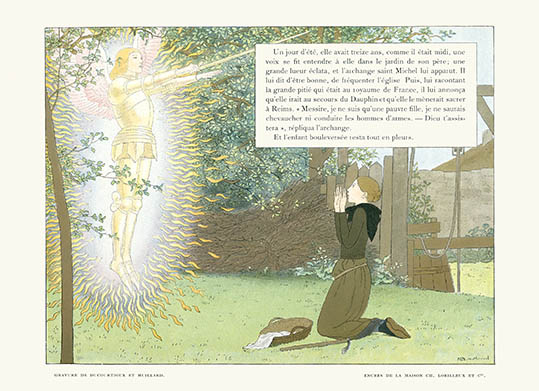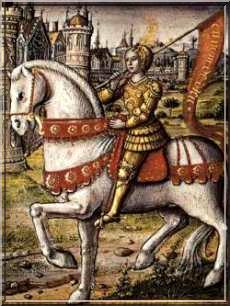December 2012
by Gael Stirler (December, 2012)
|
Joan of Arc froma 16th century Book of Hours |
This year, 2012, marks the 600th anniversary of the birth of a remarkable woman known variously as the Maid of France, Jehanne la Purcelle, Johanne d'Arc, and Joan of Arc. In January 1412, a French peasant girl was born into a humble family and though she lived only 19 short years, she changed the course of history. Her story has inspired generation after generation. It sounds like a Victorian romance at first. A naive young woman from the country goes to the French court where she is swept up in the drama of war. But the story turns into one of heroism, action, passion, betrayal, trials, and revolution. You can read the short version of her biography here in an article about Joan of Arc from 2010. There are many misconceptions that people have about her story and here are a few along with the truth.
Misconception: Her name was Joan of Arc and she came from a town called Arc.
Truth: Neither was her name Joan nor did she come from Arc. Though illiterate, she could sign her name. When she did, she signed it "Johanne" or Jehanne." It was the French feminine form of "John" which was translated to "Joan" by her English captors. She didn't come from any place named Arc but was born and raised in Domrémy in northeastern France. The surname "d'Arc" was a misunderstanding of her father's name which was pronounced "Dark" but written nine different ways in the original records. In any case, at that time it was custom for young girls to take their mother's last name not their father's. Her mother went by both Isabelle Romée and Isabelle de Vouthon. Joan didn't think she even had a last name and just refered to herself as "Jehanne la Pucelle" meaning "the Maiden." Shakespeare called her both "Joan la Pucelle" and "Joan of Arc" in Henry VI, Part 1 but it was not until the mid-19th century that her name was standardized as Joan d'Arc or Joan of Arc.
Misconception: Joan of Arc was crazy or had epilepsy.
Truth: Joan claimed to hear divine voices who told her to save France, therefore some modern scholars have concluded that she was suffering from some mental illness that caused auditory hallucinations. However, every contemporary who wrote about her—and the number is vast—spoke of her health and intelligence. They remarked on her clarity and understanding of law, even though she couldn't read. She must have had a remarkable memory. These writers were very learned lawyers and physicians, well-aquainted with mental illness. The King of France Charles VII and his family had dealt with mental illness first hand. Charles VI, his father, suffered from paranoia and thought that he was made of glass. He was convinced that the slightest bump would shatter him. Eventually he had to be locked in his home. Charles VII and his family would never have placed their lives and fortunes in the hands of Joan la Pucelle if they had seen any hint of madness about her.
 |
| A page from Jeanne d'Arc by M. Boutet De Monvel. |
Misconception: Joan of Arc always dressed as a man.
Truth: Joan dressed in men's clothing and armor when she was in battle or had to ride a horse. She dressed as a young woman the rest of the time. She didn't have anything against women's clothing. Contemporary writers said that when she was dressed as a maiden she was quiet, sweet, and demure but when she wore men's clothing she was bold and commanding. Whether this was because her mannerisms changed or whether it was the prejudice of the viewers, we will never know.
Misconception: She was burned at the stake for witchcraft.
Truth: She was tried and convicted of heresy in a court of inquisition. She wasn't even accused of witchcraft. In fact she wasn't tried in a civil or military court because even the "English notary, Nicolas Bailly, commissioned to collect testimony against Joan, could find no adverse evidence." Of all the crimes she was accused of, only two stuck. First, heresy for claiming that the "voices" that guided her were divine, and second that she wore masculine clothing against the laws of God as written in Deuteronomy.
|
Medallion minted in |
Misconception: Joan was a feminist.
Truth: According to Wikipedia.
Joan of Arc was not a feminist. She operated within a religious tradition that believed an exceptional person from any level of society might receive a divine calling. She expelled women from the French army and may have struck one stubborn camp follower with the flat of a sword.
Misconception: She has been a saint since her death during the Middle Ages.
Truth: A second trial 25 years after her death found her not-guilty of any crime on July 7, 1456. A panel of theologians studied the testimony of 115 witnesses from the original trial and concluded that Joan was innocent of the charges and was a martyr. All of this paved the way to her offical sainthood but she wasn't beatified until 1909 and cannonized (elevated to sainthood) in 1920, less than 100 years ago.
Misconception: The coming of Joan of Arc was prophecied by Merlin the Magician.
Truth: Merlin may have prophesied the return of King Arthur to England but not Joan of Arc. The prohecies about Joan were attributed to several sources including St. Bede the Venerable. The prophecies circulated in the kingdom long before Joan left Domrémy and told of an armed woman that would come from the borders of Lorraine and save France. They were "widely known in France at around that time and many in France among the supporters of the Dauphin identified Joan with the Maiden in the prophecies and this identification contributed to her popularity and following." (Wikipedia.) She was aware of the prophesies and during her posthumus trial her uncle testified that she told him, "Was it not said that France would be ruined through a woman and afterwards restored by a virgin?"
|
If you want to add this article to your list of favorites or email it to a friend, please use this permanent URL, https://stores.renstore.com/-strse-template/1212A/Page.bok. Permission is granted by the author to quote from this page or use it in handouts as long as you include a link back to Renstore.com. |
|


